Coms 018: Intercultural Communication - Co-Cultural Theory Analysis
VerifiedAdded on 2022/12/15
|13
|1036
|192
Report
AI Summary
This report provides an in-depth analysis of the Co-Cultural Communication Theory, focusing on its core tenets, development, and application within the context of intercultural communication. The paper examines the theory's explanation of how marginalized groups communicate with dominant groups, including strategies like assimilation, accommodation, and separation. It discusses the work of Mark Orbe, the theorist behind this framework, and explores the theory's strengths and weaknesses, such as its limited scope on communicative strategies. The analysis includes discussion questions and a comprehensive reference list, offering a valuable resource for students studying communication theories and intercultural dynamics. The assignment fulfills the requirements of a Coms 018 course, including discussion of the theory's origin, application, and critical evaluation, with references to relevant literature.

CO-CULTURAL
COMMUNICATION
THEORY
COMMUNICATION
THEORY
Paraphrase This Document
Need a fresh take? Get an instant paraphrase of this document with our AI Paraphraser
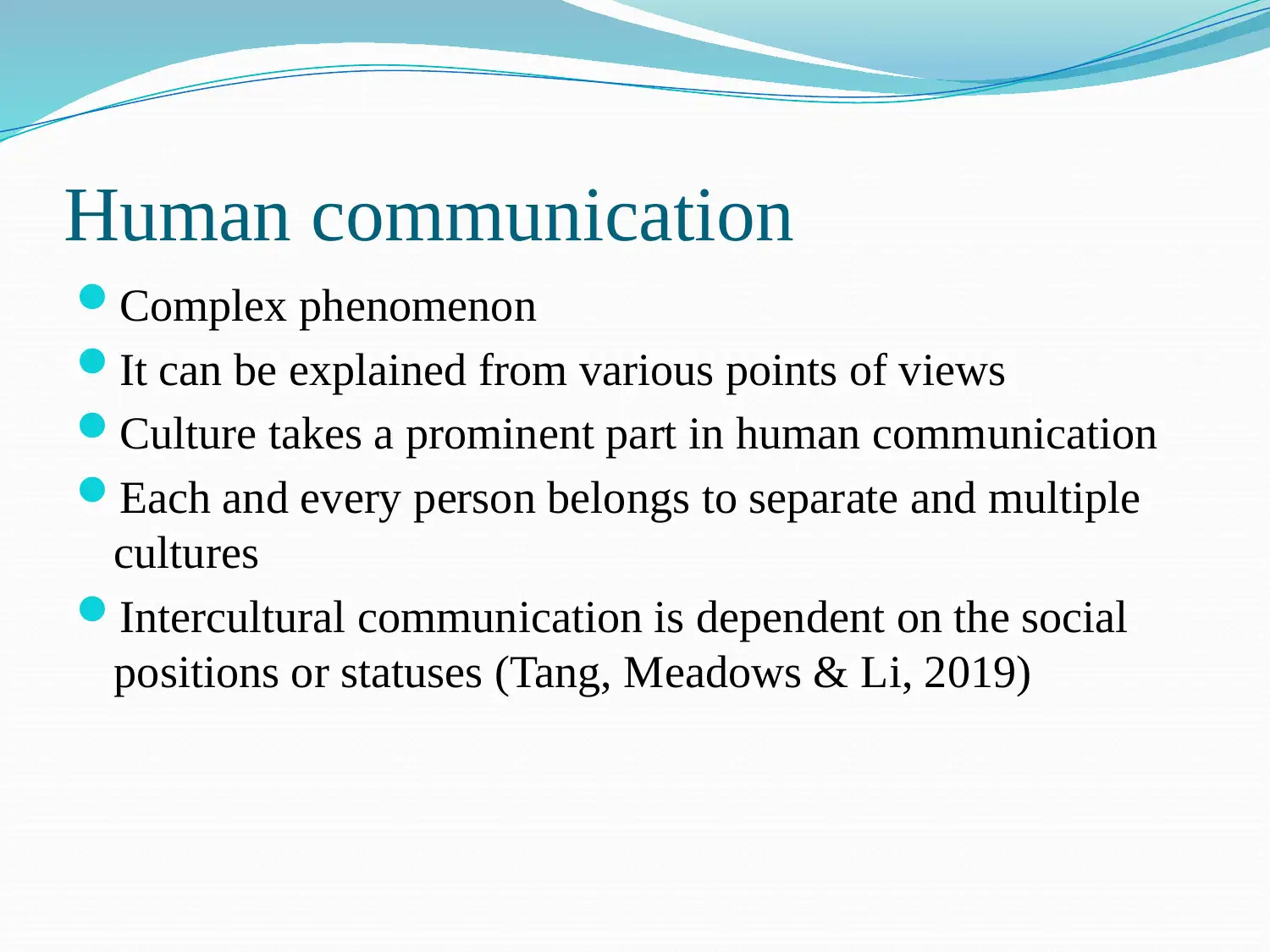
Human communication
Complex phenomenon
It can be explained from various points of views
Culture takes a prominent part in human communication
Each and every person belongs to separate and multiple
cultures
Intercultural communication is dependent on the social
positions or statuses (Tang, Meadows & Li, 2019)
Complex phenomenon
It can be explained from various points of views
Culture takes a prominent part in human communication
Each and every person belongs to separate and multiple
cultures
Intercultural communication is dependent on the social
positions or statuses (Tang, Meadows & Li, 2019)
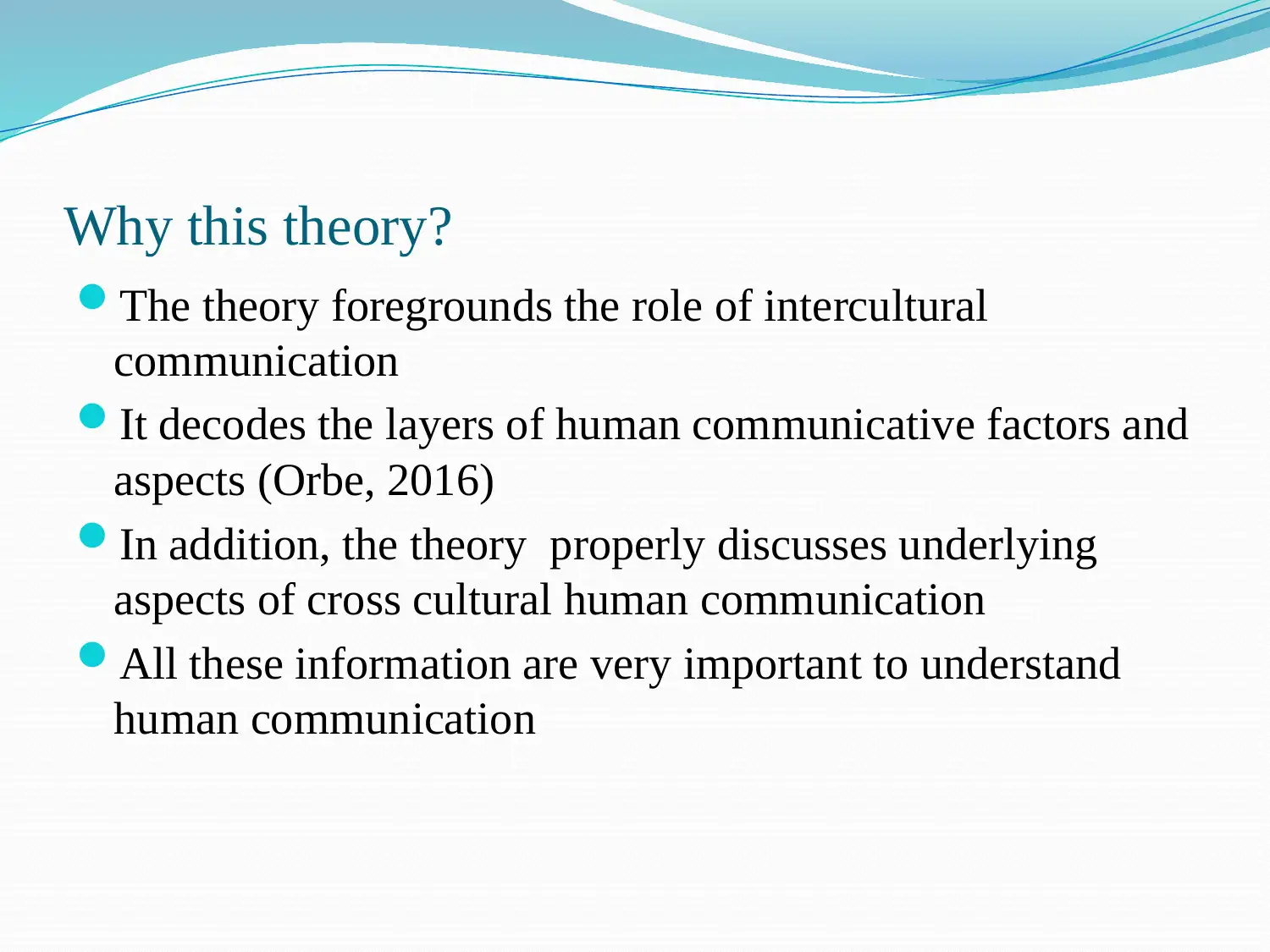
Why this theory?
The theory foregrounds the role of intercultural
communication
It decodes the layers of human communicative factors and
aspects (Orbe, 2016)
In addition, the theory properly discusses underlying
aspects of cross cultural human communication
All these information are very important to understand
human communication
The theory foregrounds the role of intercultural
communication
It decodes the layers of human communicative factors and
aspects (Orbe, 2016)
In addition, the theory properly discusses underlying
aspects of cross cultural human communication
All these information are very important to understand
human communication
⊘ This is a preview!⊘
Do you want full access?
Subscribe today to unlock all pages.

Trusted by 1+ million students worldwide
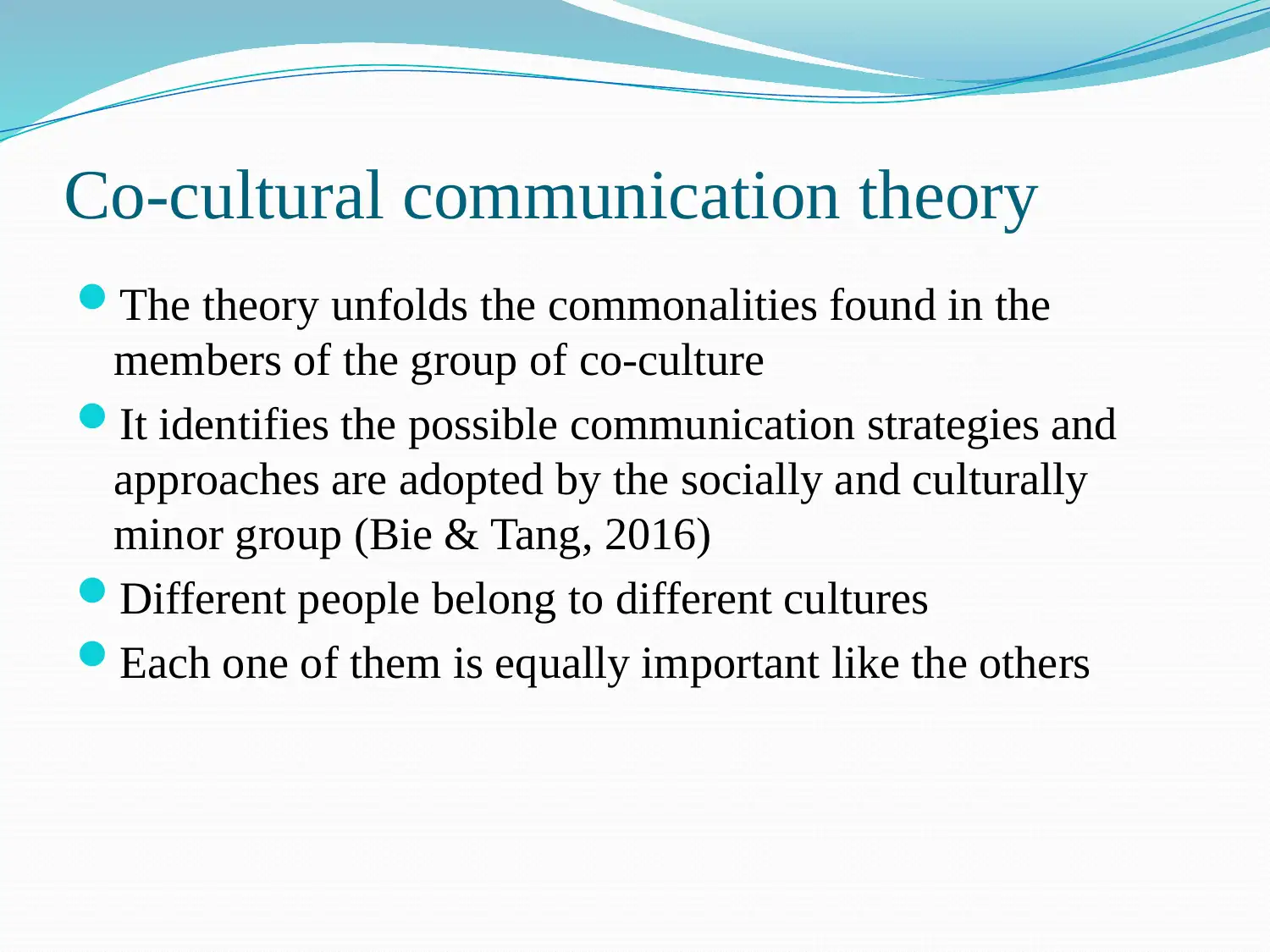
Co-cultural communication theory
The theory unfolds the commonalities found in the
members of the group of co-culture
It identifies the possible communication strategies and
approaches are adopted by the socially and culturally
minor group (Bie & Tang, 2016)
Different people belong to different cultures
Each one of them is equally important like the others
The theory unfolds the commonalities found in the
members of the group of co-culture
It identifies the possible communication strategies and
approaches are adopted by the socially and culturally
minor group (Bie & Tang, 2016)
Different people belong to different cultures
Each one of them is equally important like the others
Paraphrase This Document
Need a fresh take? Get an instant paraphrase of this document with our AI Paraphraser
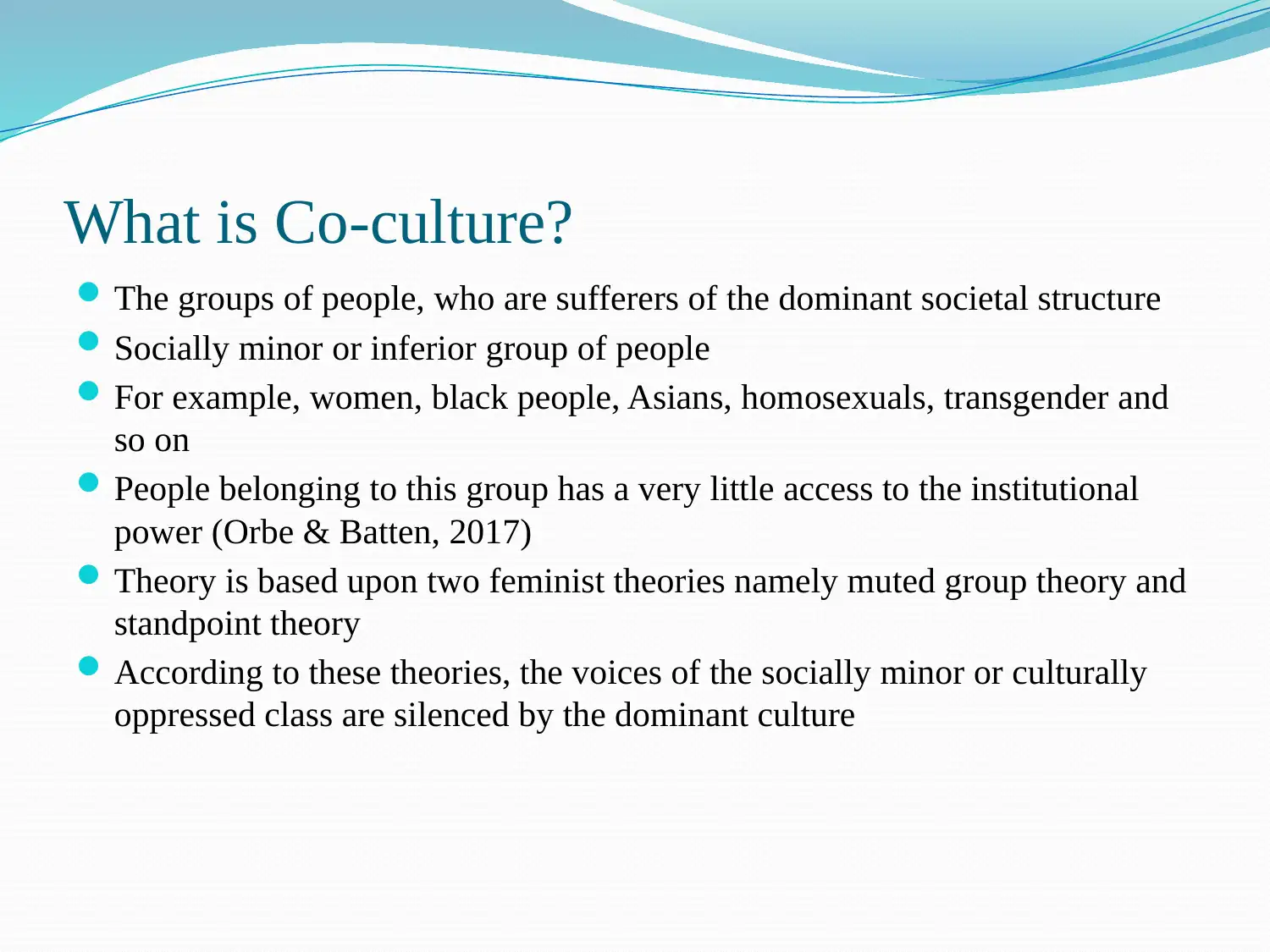
What is Co-culture?
The groups of people, who are sufferers of the dominant societal structure
Socially minor or inferior group of people
For example, women, black people, Asians, homosexuals, transgender and
so on
People belonging to this group has a very little access to the institutional
power (Orbe & Batten, 2017)
Theory is based upon two feminist theories namely muted group theory and
standpoint theory
According to these theories, the voices of the socially minor or culturally
oppressed class are silenced by the dominant culture
The groups of people, who are sufferers of the dominant societal structure
Socially minor or inferior group of people
For example, women, black people, Asians, homosexuals, transgender and
so on
People belonging to this group has a very little access to the institutional
power (Orbe & Batten, 2017)
Theory is based upon two feminist theories namely muted group theory and
standpoint theory
According to these theories, the voices of the socially minor or culturally
oppressed class are silenced by the dominant culture
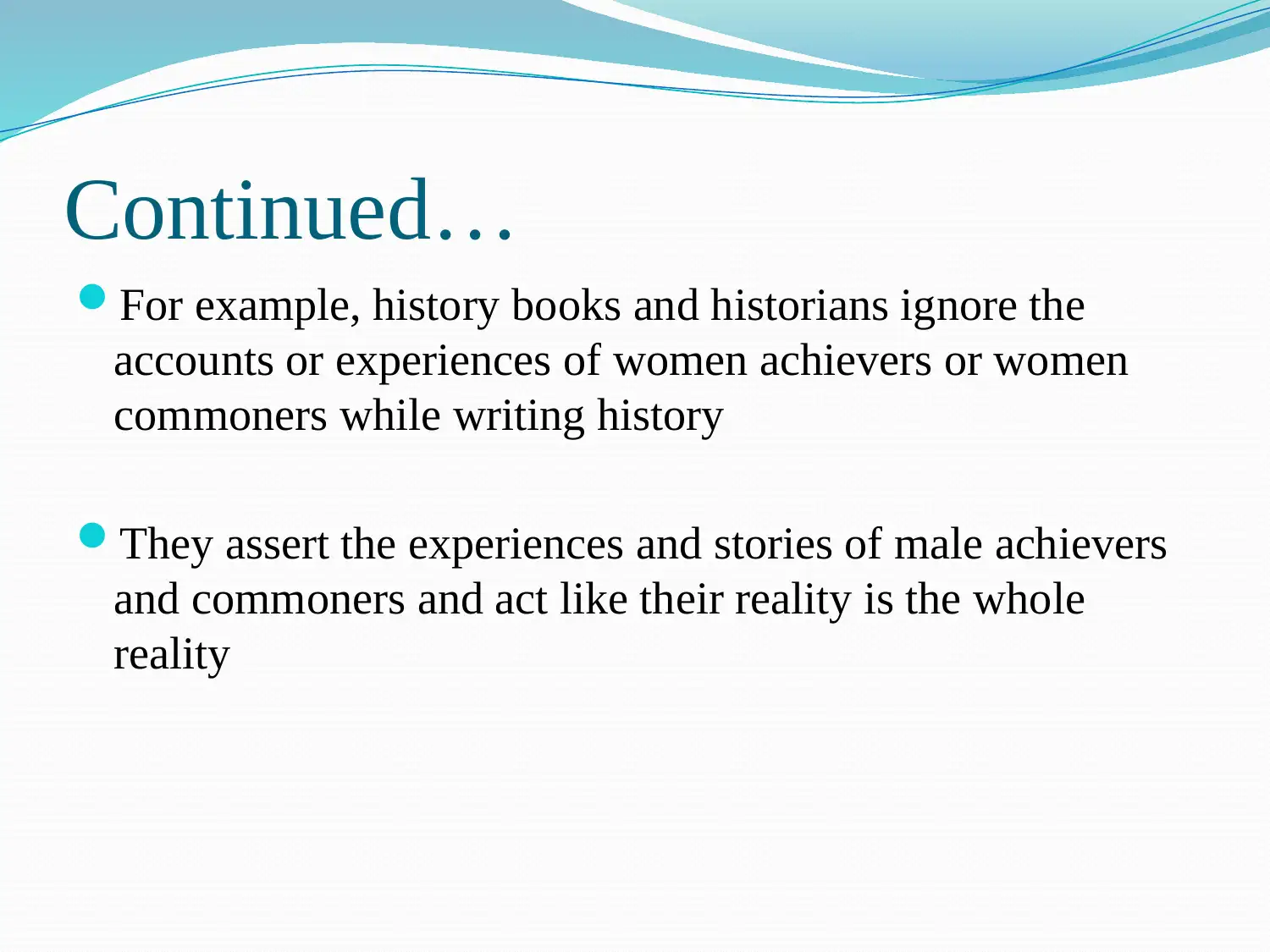
Continued…
For example, history books and historians ignore the
accounts or experiences of women achievers or women
commoners while writing history
They assert the experiences and stories of male achievers
and commoners and act like their reality is the whole
reality
For example, history books and historians ignore the
accounts or experiences of women achievers or women
commoners while writing history
They assert the experiences and stories of male achievers
and commoners and act like their reality is the whole
reality
⊘ This is a preview!⊘
Do you want full access?
Subscribe today to unlock all pages.

Trusted by 1+ million students worldwide
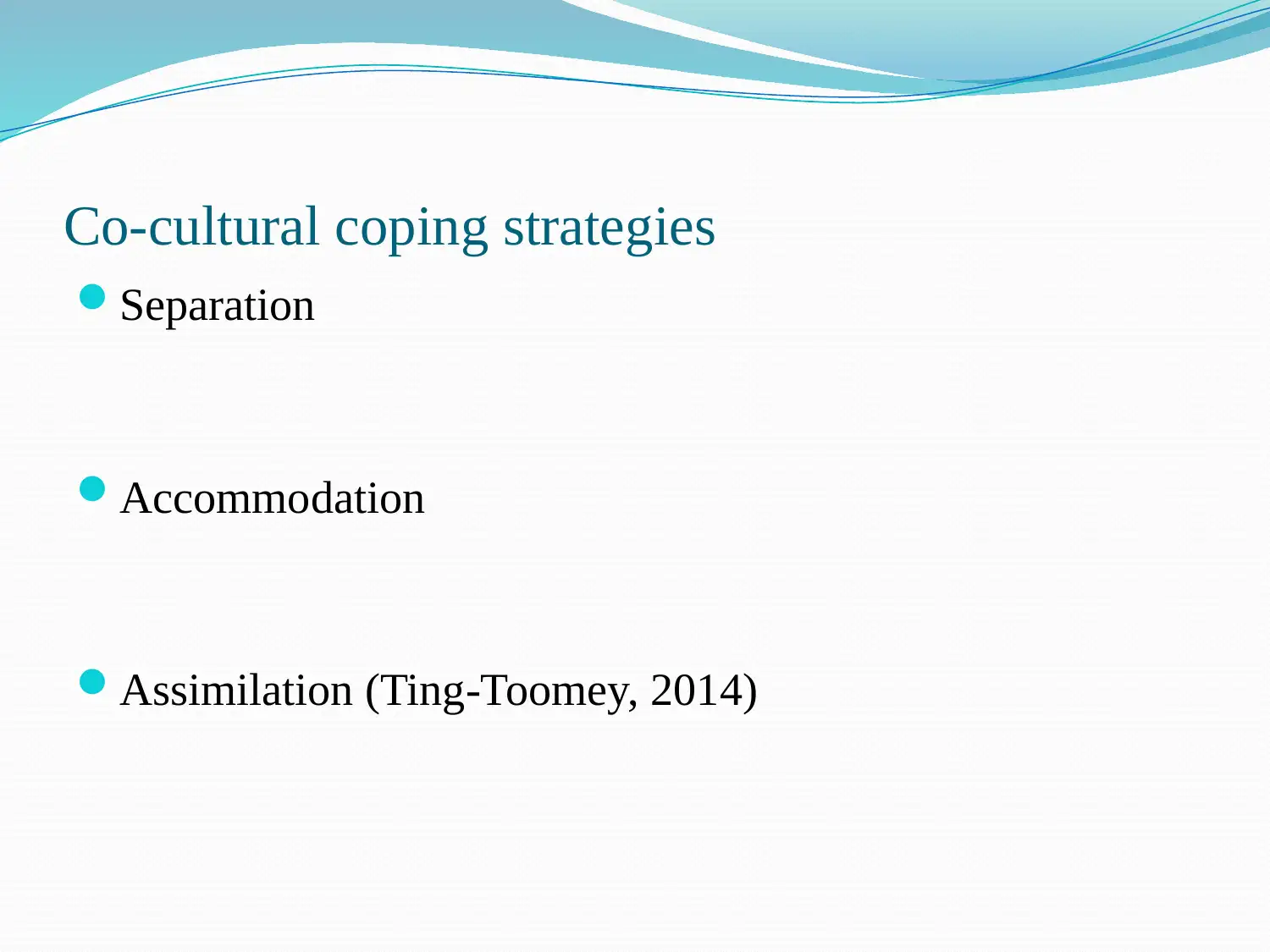
Co-cultural coping strategies
Separation
Accommodation
Assimilation (Ting-Toomey, 2014)
Separation
Accommodation
Assimilation (Ting-Toomey, 2014)
Paraphrase This Document
Need a fresh take? Get an instant paraphrase of this document with our AI Paraphraser
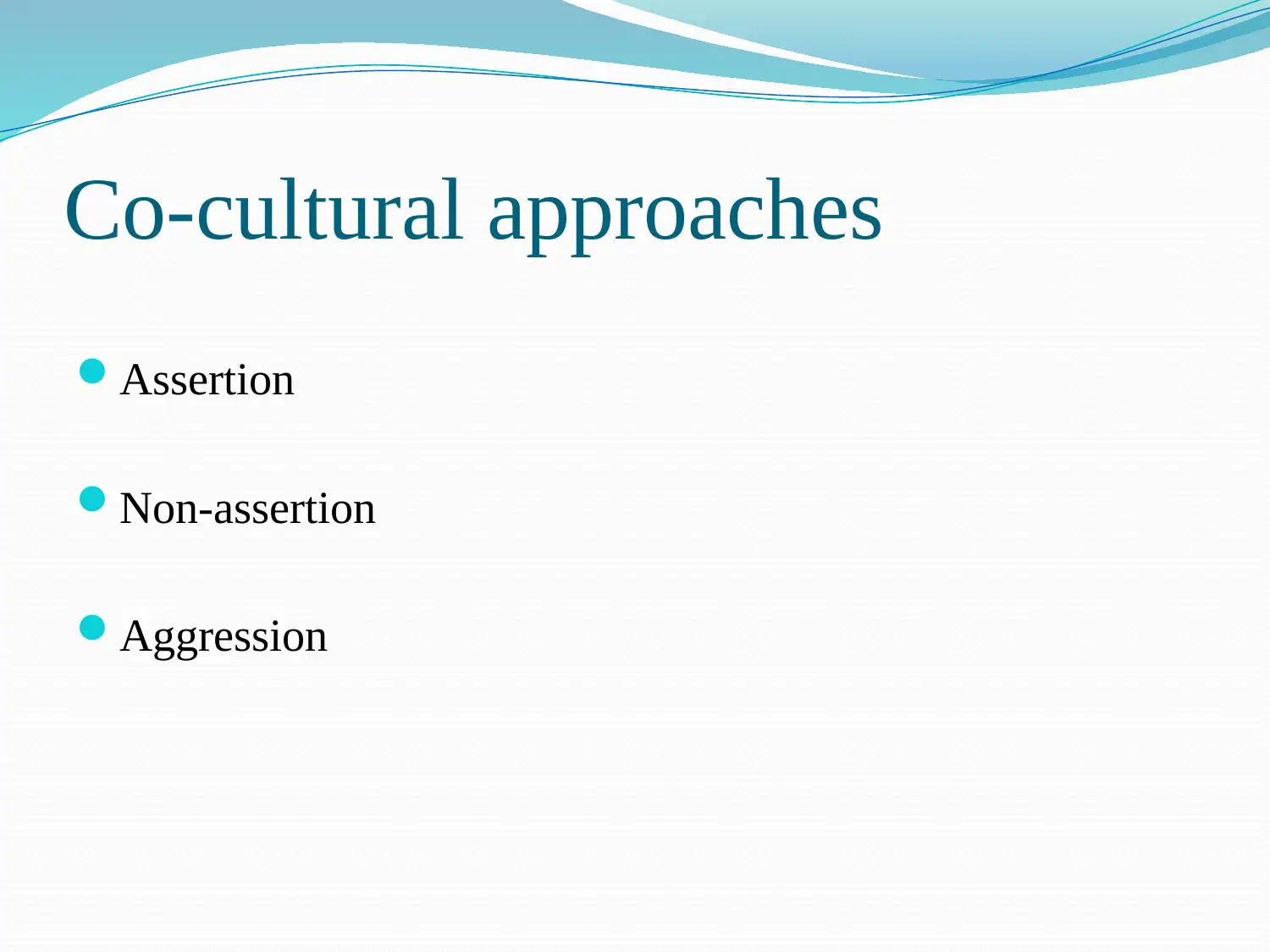
Co-cultural approaches
Assertion
Non-assertion
Aggression
Assertion
Non-assertion
Aggression
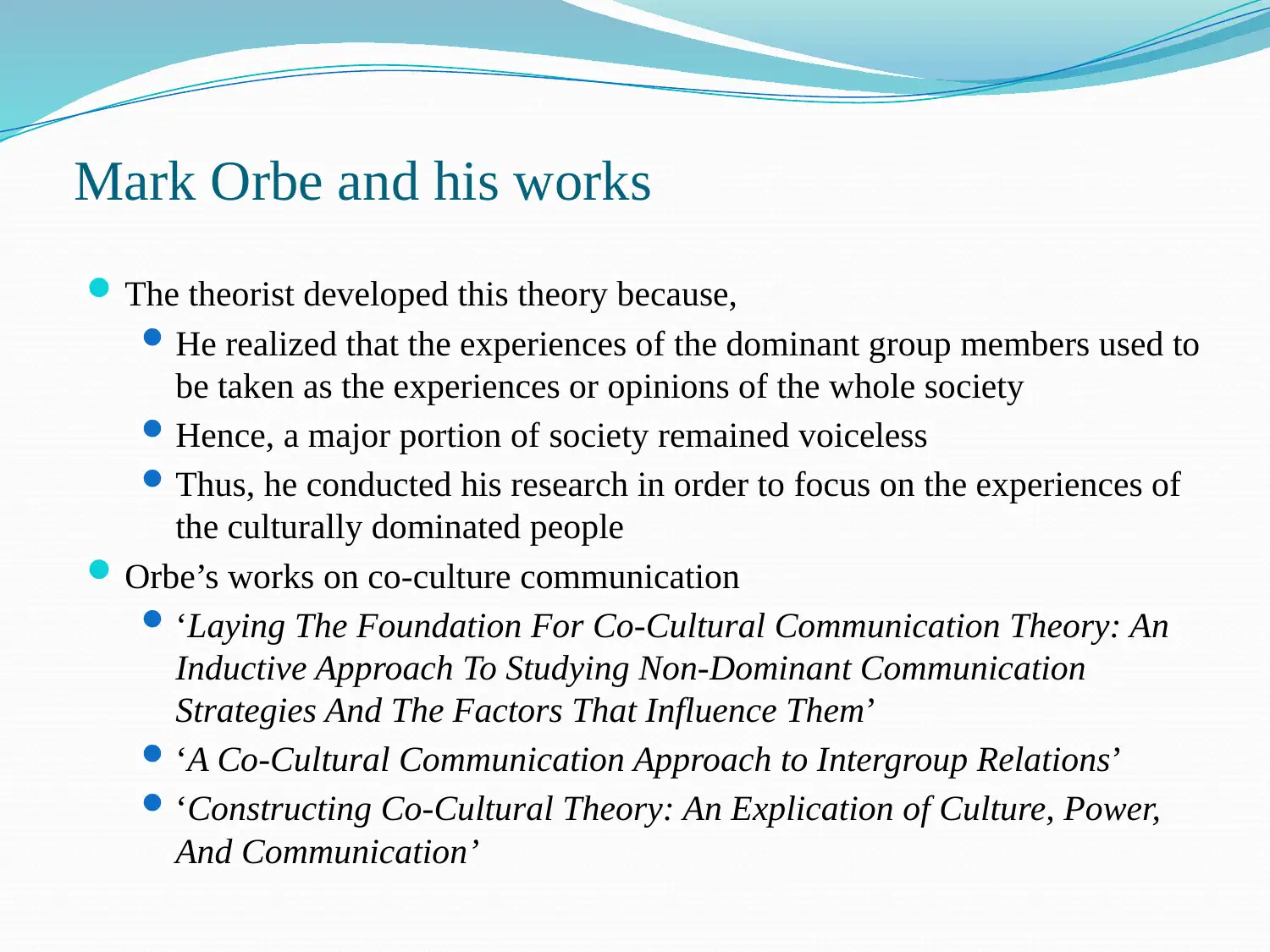
Mark Orbe and his works
The theorist developed this theory because,
He realized that the experiences of the dominant group members used to
be taken as the experiences or opinions of the whole society
Hence, a major portion of society remained voiceless
Thus, he conducted his research in order to focus on the experiences of
the culturally dominated people
Orbe’s works on co-culture communication
‘Laying The Foundation For Co-Cultural Communication Theory: An
Inductive Approach To Studying Non-Dominant Communication
Strategies And The Factors That Influence Them’
‘A Co-Cultural Communication Approach to Intergroup Relations’
‘Constructing Co-Cultural Theory: An Explication of Culture, Power,
And Communication’
The theorist developed this theory because,
He realized that the experiences of the dominant group members used to
be taken as the experiences or opinions of the whole society
Hence, a major portion of society remained voiceless
Thus, he conducted his research in order to focus on the experiences of
the culturally dominated people
Orbe’s works on co-culture communication
‘Laying The Foundation For Co-Cultural Communication Theory: An
Inductive Approach To Studying Non-Dominant Communication
Strategies And The Factors That Influence Them’
‘A Co-Cultural Communication Approach to Intergroup Relations’
‘Constructing Co-Cultural Theory: An Explication of Culture, Power,
And Communication’
⊘ This is a preview!⊘
Do you want full access?
Subscribe today to unlock all pages.

Trusted by 1+ million students worldwide
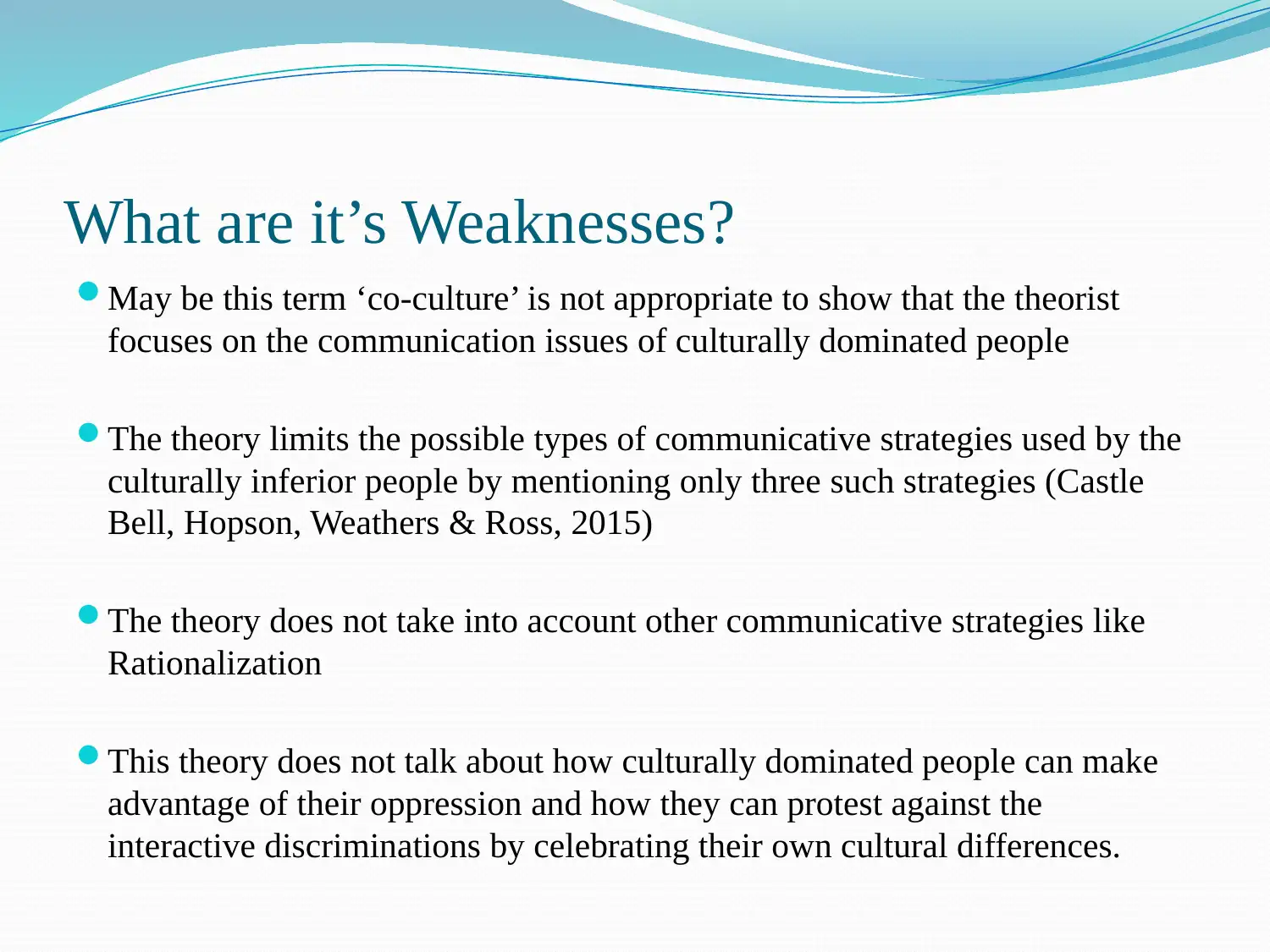
What are it’s Weaknesses?
May be this term ‘co-culture’ is not appropriate to show that the theorist
focuses on the communication issues of culturally dominated people
The theory limits the possible types of communicative strategies used by the
culturally inferior people by mentioning only three such strategies (Castle
Bell, Hopson, Weathers & Ross, 2015)
The theory does not take into account other communicative strategies like
Rationalization
This theory does not talk about how culturally dominated people can make
advantage of their oppression and how they can protest against the
interactive discriminations by celebrating their own cultural differences.
May be this term ‘co-culture’ is not appropriate to show that the theorist
focuses on the communication issues of culturally dominated people
The theory limits the possible types of communicative strategies used by the
culturally inferior people by mentioning only three such strategies (Castle
Bell, Hopson, Weathers & Ross, 2015)
The theory does not take into account other communicative strategies like
Rationalization
This theory does not talk about how culturally dominated people can make
advantage of their oppression and how they can protest against the
interactive discriminations by celebrating their own cultural differences.
Paraphrase This Document
Need a fresh take? Get an instant paraphrase of this document with our AI Paraphraser
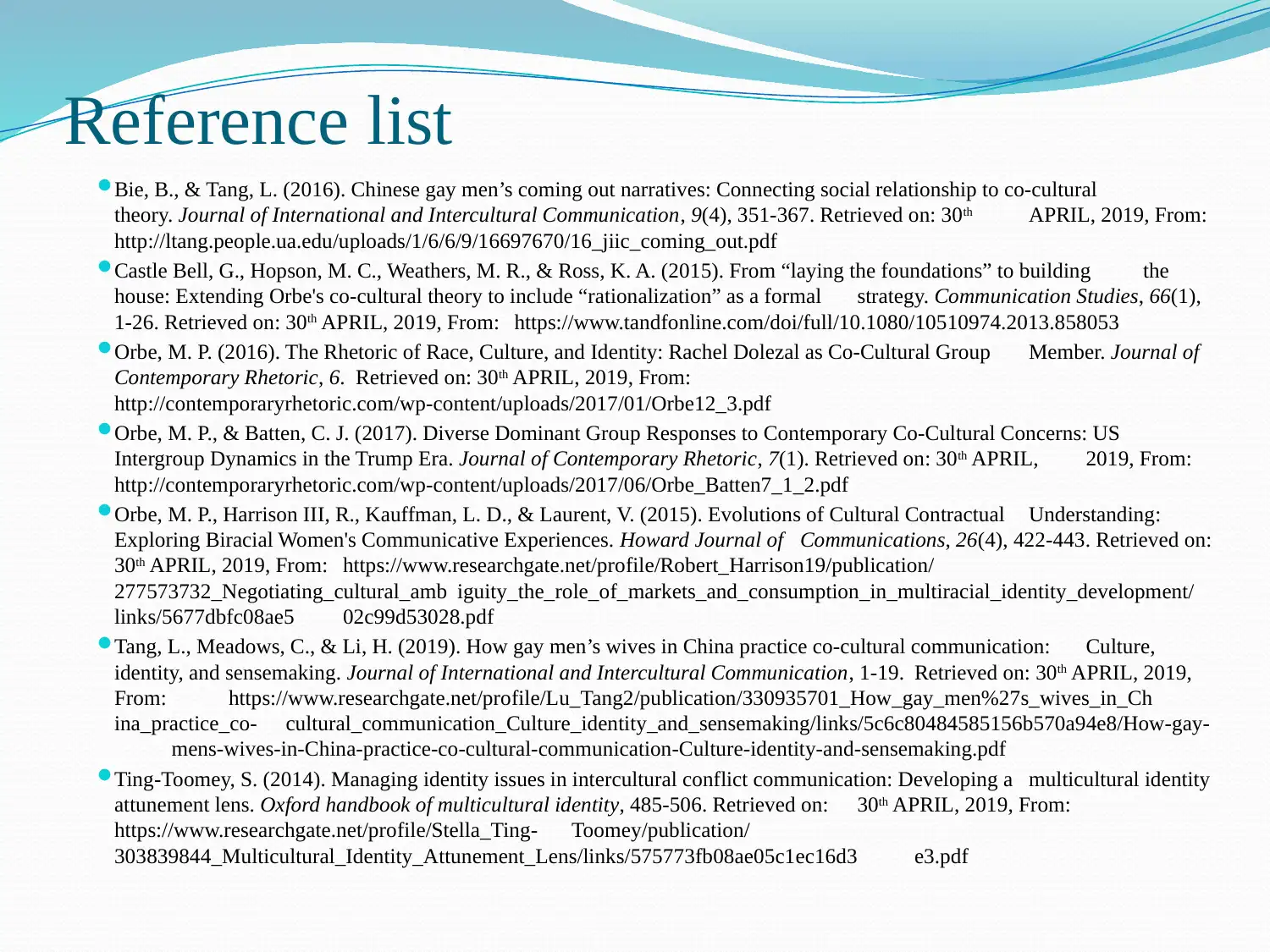
Reference list
Bie, B., & Tang, L. (2016). Chinese gay men’s coming out narratives: Connecting social relationship to co-cultural
theory. Journal of International and Intercultural Communication, 9(4), 351-367. Retrieved on: 30th APRIL, 2019, From:
http://ltang.people.ua.edu/uploads/1/6/6/9/16697670/16_jiic_coming_out.pdf
Castle Bell, G., Hopson, M. C., Weathers, M. R., & Ross, K. A. (2015). From “laying the foundations” to building the
house: Extending Orbe's co-cultural theory to include “rationalization” as a formal strategy. Communication Studies, 66(1),
1-26. Retrieved on: 30th APRIL, 2019, From: https://www.tandfonline.com/doi/full/10.1080/10510974.2013.858053
Orbe, M. P. (2016). The Rhetoric of Race, Culture, and Identity: Rachel Dolezal as Co-Cultural Group Member. Journal of
Contemporary Rhetoric, 6. Retrieved on: 30th APRIL, 2019, From:
http://contemporaryrhetoric.com/wp-content/uploads/2017/01/Orbe12_3.pdf
Orbe, M. P., & Batten, C. J. (2017). Diverse Dominant Group Responses to Contemporary Co-Cultural Concerns: US
Intergroup Dynamics in the Trump Era. Journal of Contemporary Rhetoric, 7(1). Retrieved on: 30th APRIL, 2019, From:
http://contemporaryrhetoric.com/wp-content/uploads/2017/06/Orbe_Batten7_1_2.pdf
Orbe, M. P., Harrison III, R., Kauffman, L. D., & Laurent, V. (2015). Evolutions of Cultural Contractual Understanding:
Exploring Biracial Women's Communicative Experiences. Howard Journal of Communications, 26(4), 422-443. Retrieved on:
30th APRIL, 2019, From: https://www.researchgate.net/profile/Robert_Harrison19/publication/
277573732_Negotiating_cultural_amb iguity_the_role_of_markets_and_consumption_in_multiracial_identity_development/
links/5677dbfc08ae5 02c99d53028.pdf
Tang, L., Meadows, C., & Li, H. (2019). How gay men’s wives in China practice co-cultural communication: Culture,
identity, and sensemaking. Journal of International and Intercultural Communication, 1-19. Retrieved on: 30th APRIL, 2019,
From: https://www.researchgate.net/profile/Lu_Tang2/publication/330935701_How_gay_men%27s_wives_in_Ch
ina_practice_co- cultural_communication_Culture_identity_and_sensemaking/links/5c6c80484585156b570a94e8/How-gay-
mens-wives-in-China-practice-co-cultural-communication-Culture-identity-and-sensemaking.pdf
Ting-Toomey, S. (2014). Managing identity issues in intercultural conflict communication: Developing a multicultural identity
attunement lens. Oxford handbook of multicultural identity, 485-506. Retrieved on: 30th APRIL, 2019, From:
https://www.researchgate.net/profile/Stella_Ting- Toomey/publication/
303839844_Multicultural_Identity_Attunement_Lens/links/575773fb08ae05c1ec16d3 e3.pdf
Bie, B., & Tang, L. (2016). Chinese gay men’s coming out narratives: Connecting social relationship to co-cultural
theory. Journal of International and Intercultural Communication, 9(4), 351-367. Retrieved on: 30th APRIL, 2019, From:
http://ltang.people.ua.edu/uploads/1/6/6/9/16697670/16_jiic_coming_out.pdf
Castle Bell, G., Hopson, M. C., Weathers, M. R., & Ross, K. A. (2015). From “laying the foundations” to building the
house: Extending Orbe's co-cultural theory to include “rationalization” as a formal strategy. Communication Studies, 66(1),
1-26. Retrieved on: 30th APRIL, 2019, From: https://www.tandfonline.com/doi/full/10.1080/10510974.2013.858053
Orbe, M. P. (2016). The Rhetoric of Race, Culture, and Identity: Rachel Dolezal as Co-Cultural Group Member. Journal of
Contemporary Rhetoric, 6. Retrieved on: 30th APRIL, 2019, From:
http://contemporaryrhetoric.com/wp-content/uploads/2017/01/Orbe12_3.pdf
Orbe, M. P., & Batten, C. J. (2017). Diverse Dominant Group Responses to Contemporary Co-Cultural Concerns: US
Intergroup Dynamics in the Trump Era. Journal of Contemporary Rhetoric, 7(1). Retrieved on: 30th APRIL, 2019, From:
http://contemporaryrhetoric.com/wp-content/uploads/2017/06/Orbe_Batten7_1_2.pdf
Orbe, M. P., Harrison III, R., Kauffman, L. D., & Laurent, V. (2015). Evolutions of Cultural Contractual Understanding:
Exploring Biracial Women's Communicative Experiences. Howard Journal of Communications, 26(4), 422-443. Retrieved on:
30th APRIL, 2019, From: https://www.researchgate.net/profile/Robert_Harrison19/publication/
277573732_Negotiating_cultural_amb iguity_the_role_of_markets_and_consumption_in_multiracial_identity_development/
links/5677dbfc08ae5 02c99d53028.pdf
Tang, L., Meadows, C., & Li, H. (2019). How gay men’s wives in China practice co-cultural communication: Culture,
identity, and sensemaking. Journal of International and Intercultural Communication, 1-19. Retrieved on: 30th APRIL, 2019,
From: https://www.researchgate.net/profile/Lu_Tang2/publication/330935701_How_gay_men%27s_wives_in_Ch
ina_practice_co- cultural_communication_Culture_identity_and_sensemaking/links/5c6c80484585156b570a94e8/How-gay-
mens-wives-in-China-practice-co-cultural-communication-Culture-identity-and-sensemaking.pdf
Ting-Toomey, S. (2014). Managing identity issues in intercultural conflict communication: Developing a multicultural identity
attunement lens. Oxford handbook of multicultural identity, 485-506. Retrieved on: 30th APRIL, 2019, From:
https://www.researchgate.net/profile/Stella_Ting- Toomey/publication/
303839844_Multicultural_Identity_Attunement_Lens/links/575773fb08ae05c1ec16d3 e3.pdf

Discussion questions
Can you share any personal experience of yours that you can
relate to any of the aspects of co-cultural communication?
What do you think can be the negative side of applying this
theory while decoding how someone interacts with you?
Do you think that the voice of the marginalized group of
people can be dominated and suppressed by the people who
have the authoritative power in the social environment? If yes
then how?
Can you share any personal experience of yours that you can
relate to any of the aspects of co-cultural communication?
What do you think can be the negative side of applying this
theory while decoding how someone interacts with you?
Do you think that the voice of the marginalized group of
people can be dominated and suppressed by the people who
have the authoritative power in the social environment? If yes
then how?
⊘ This is a preview!⊘
Do you want full access?
Subscribe today to unlock all pages.

Trusted by 1+ million students worldwide
1 out of 13